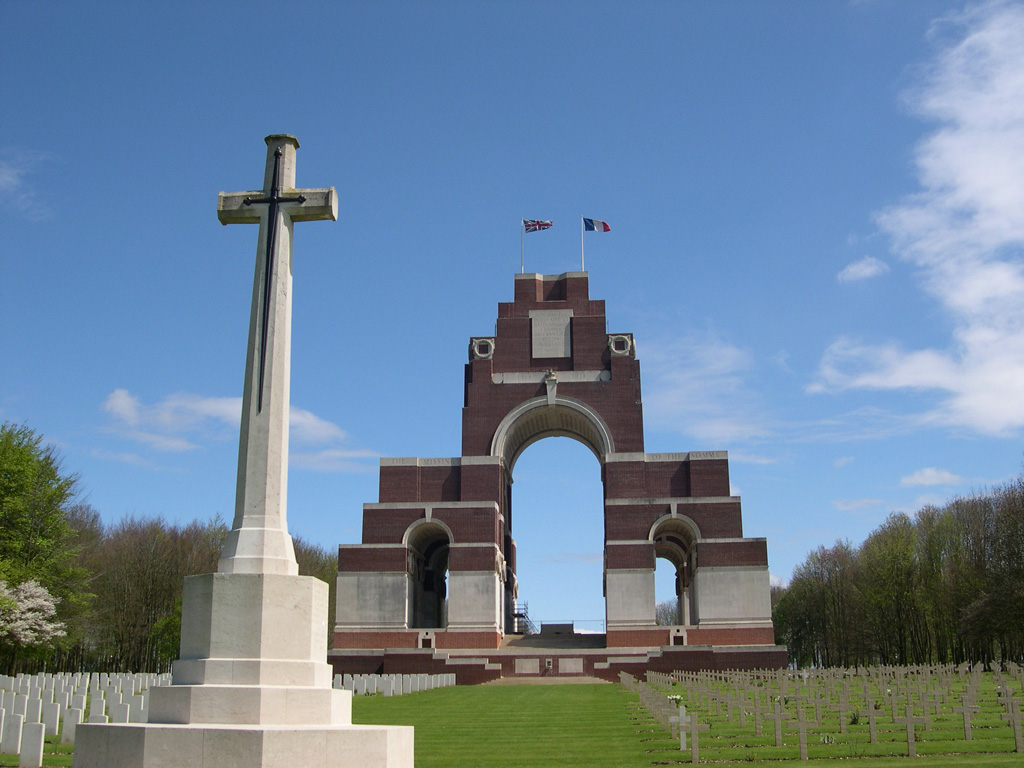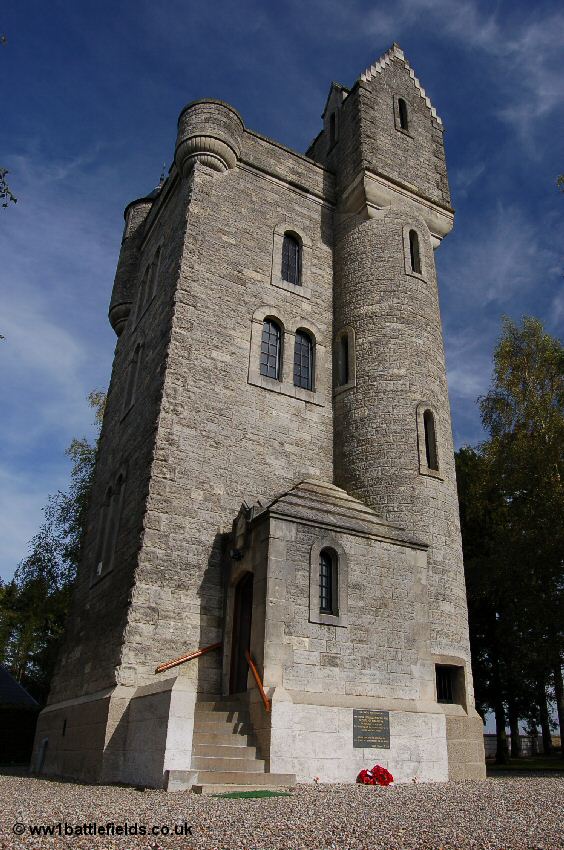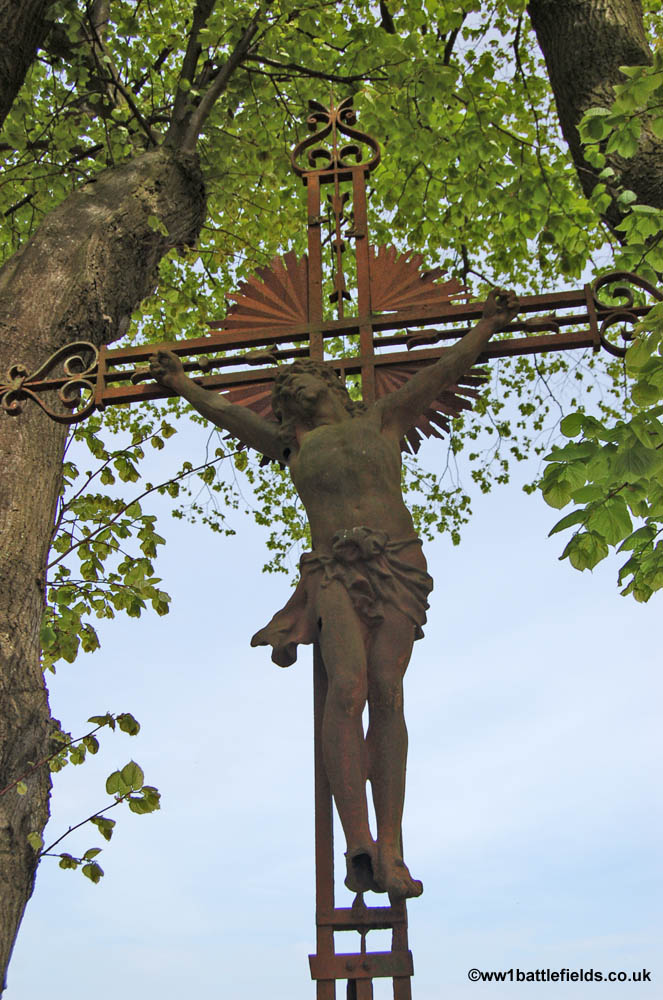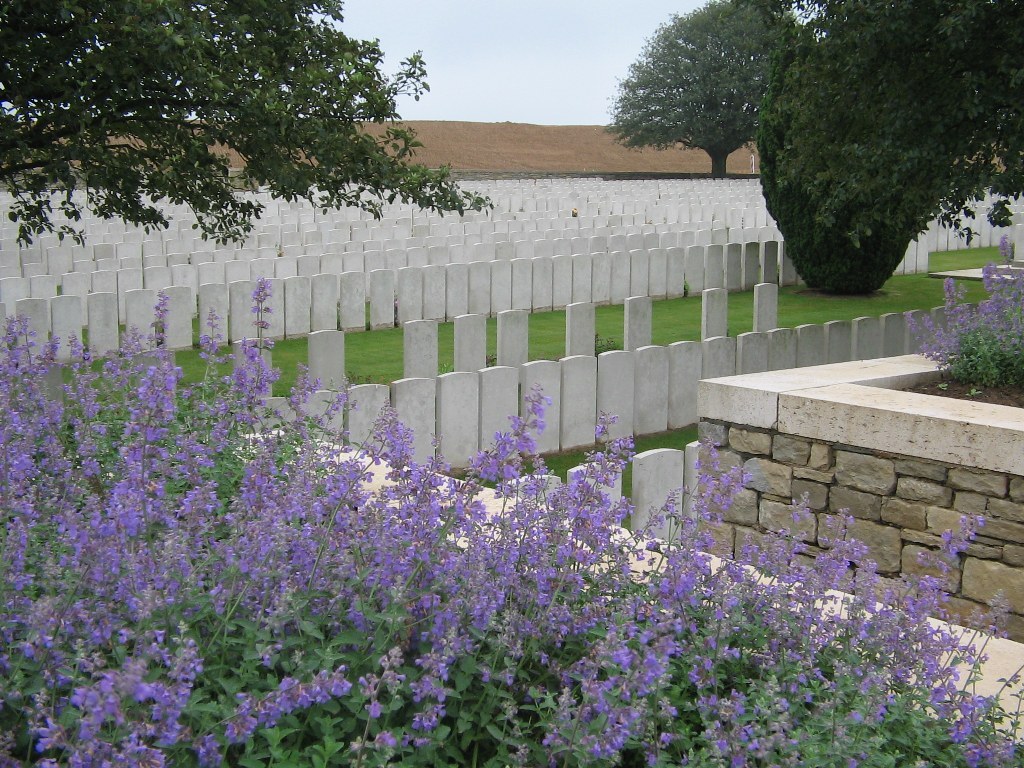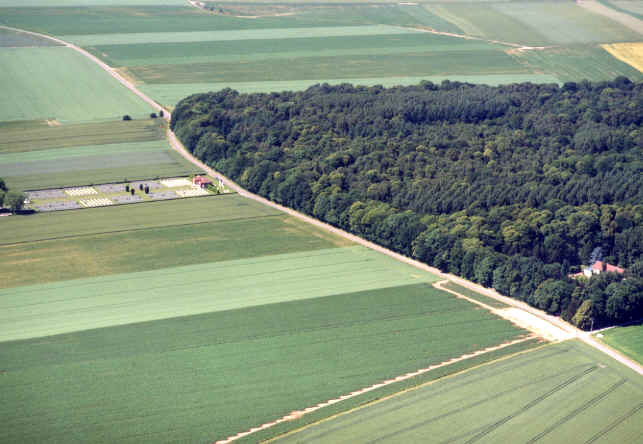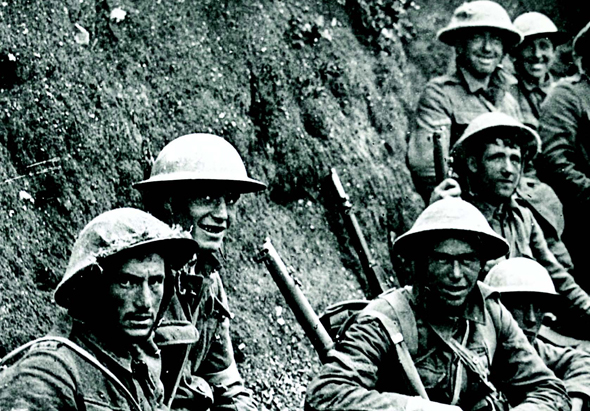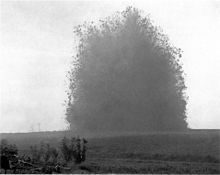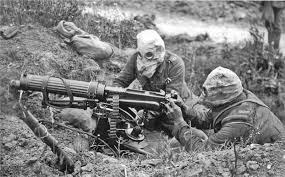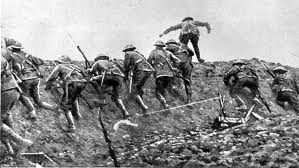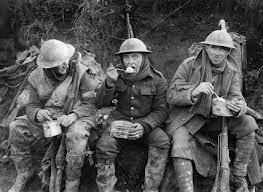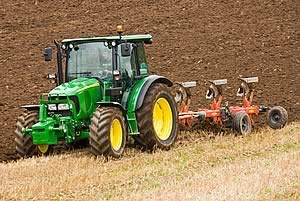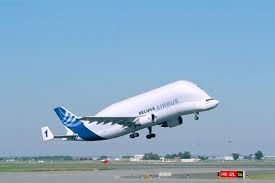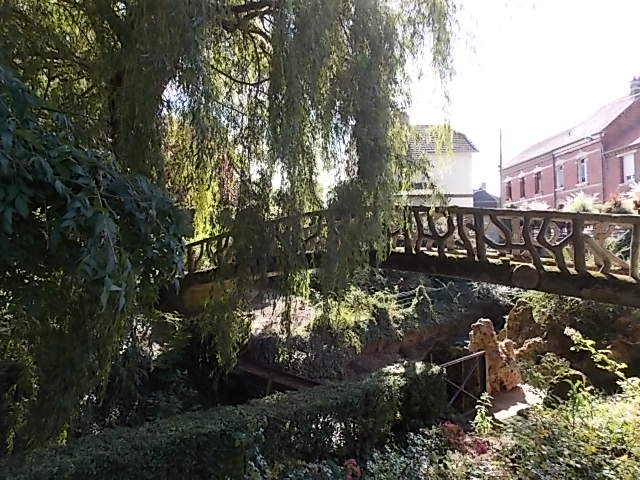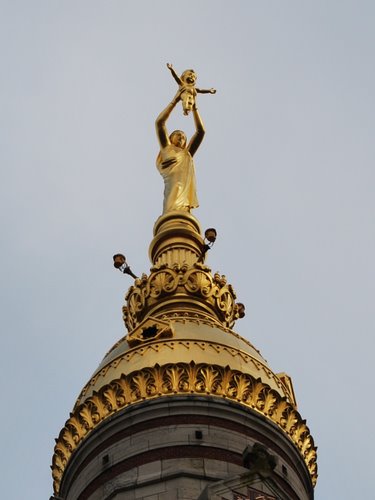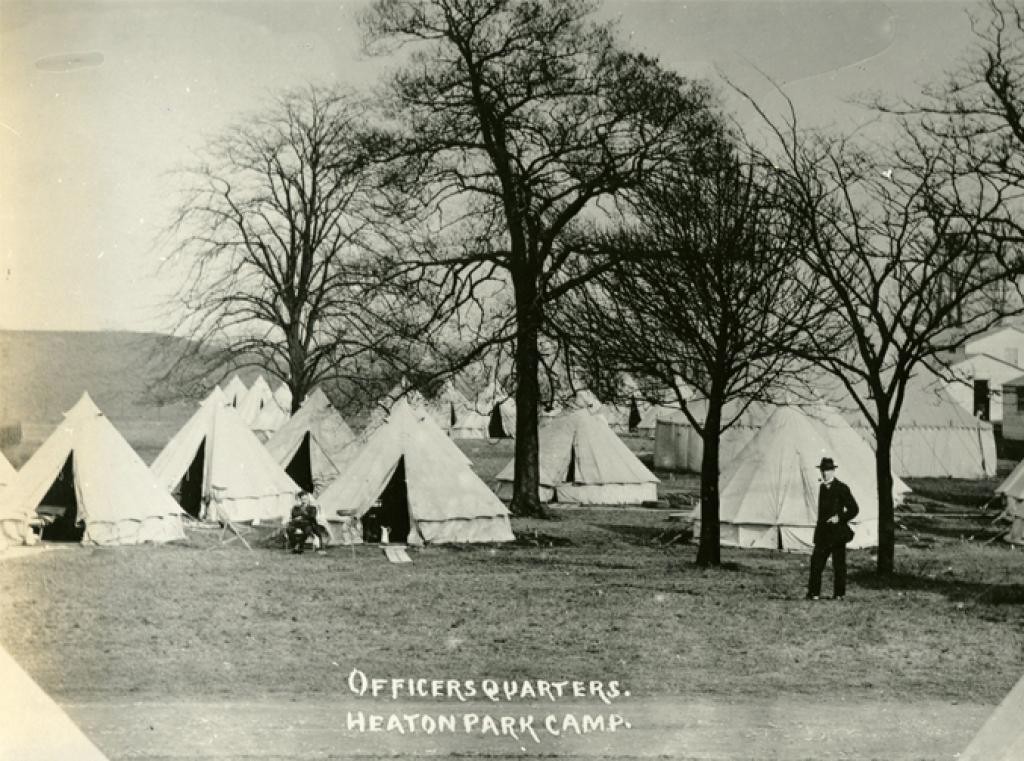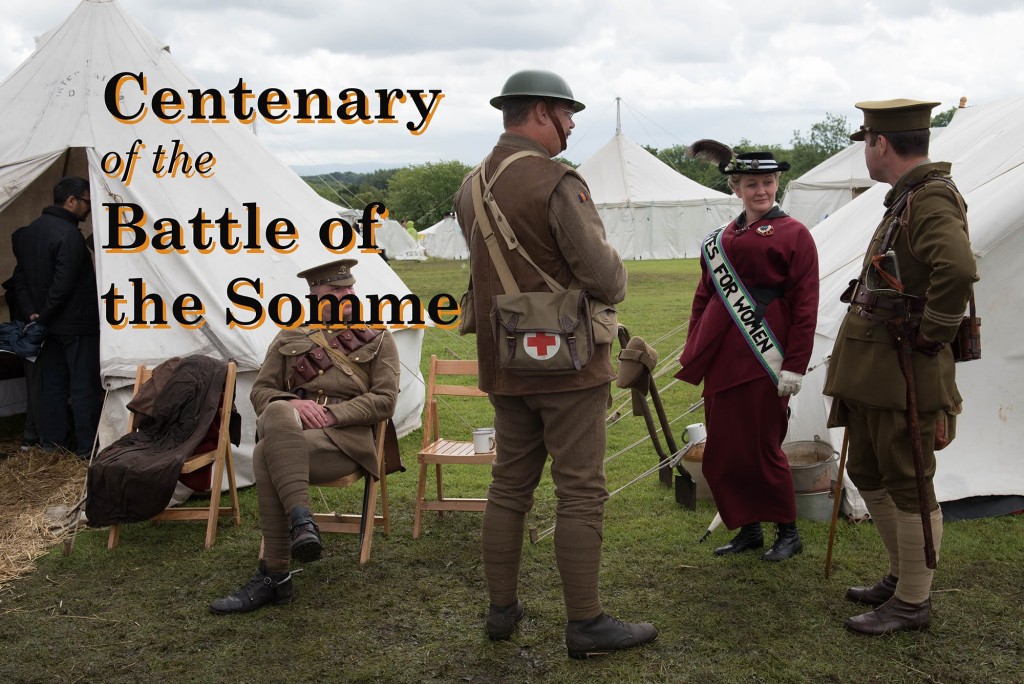The Somme…My Story
” … rows of steel helmets and glittering bayonets were to be seen along the front line. It was 7.20am Saturday 1st July 1916 and a mist-shrouded the countryside mixing with the smoke from exploding shells. The mist began to clear and at 7.25 am precisely, hundreds of scaling ladders were placed in position in the forward trenches and waves of men climbed out over the parapet and stood in the grass before their own barbed wire. When their ranks were complete they proceeded to dress off as if on the parade ground. Then at 7.30 am signallers among the ranks dropped their flags, whistles blew, and all along the front waves of khaki surged forward ..”
The course of my walk followed the front line (British Sector) on the opening day of the battle. It took in several cemeteries en-route, enabling me to pay homage to as many pre-determined individuals as possible.
To will allow me an insight into the wider picture of this immensely poignant area of history, I diverted off occasionally to see some significant landmarks of the battle.
I was fully aware that I would not be able to cover everything and had to be very disciplined in what to put in and what to leave out … balance was the key. Also, I do not profess to be a military historian (you’ve probably gathered that!), some guides have been doing this for decades, and I am sure they will tell you that they are still learning(?).
My story begins and ends at very specific points, locations that I have thought long and hard about.
~
This was my itinerary:
Day 1 (walk approx. 17 miles) – To-day I ‘walked the line’, to cover the Northern Sector. Starting at “Funky Villas” I headed south, to a very special place …
SHEFFIELD MEMORIAL PARK, SERRE
This is where my story, and tribute, started … I wanted somewhere to represent all the men  who died on The Somme.
who died on The Somme.
I chose this spot, where I could find a quiet corner to say my prayer and lay my cross … it is where the 11th Battalion of the East Lancashire Regiment went ‘over the top’. They advanced up the slope from here towards the German lines (some 200 yards away). Slaughtered in their droves, their story is the story of so many others.
You might know them better as The Accrington Pals(?)!!!.
“…a magnificent display of gallantry, discipline and determination ..not a man wavered, broke ranks or attempted to go back ..”
INFORMATION – Some families paid for inscriptions to be put on the grave of their loved one, although probably not many could afford it(?)! I have put these inscriptions on where applicable.
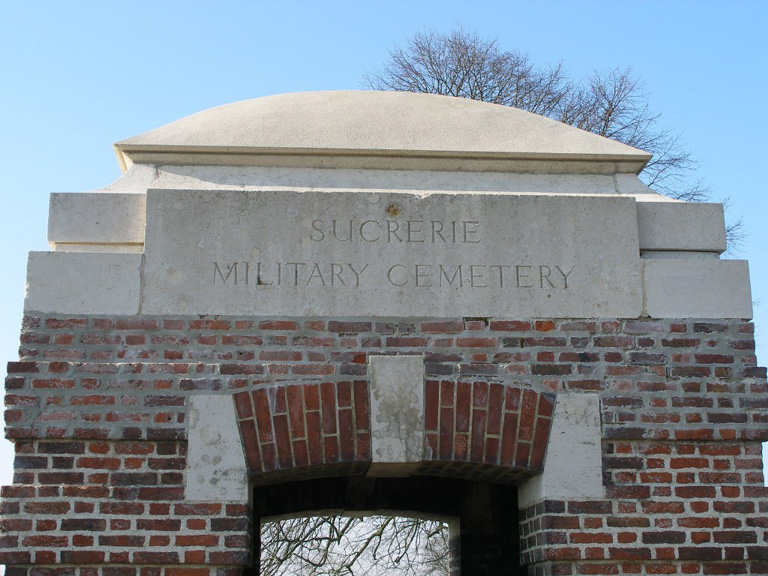 <SUCRERIE MILITARY CEMETERY, COLINCAMPS
<SUCRERIE MILITARY CEMETERY, COLINCAMPS
Private William DOBSON 33713 – 1/10th (Oldham) Btn, Manchester Regiment (Territorial Force) Ref:I J24
Private Alec WISKEN 276635 – B Coy, 1/7th Btn, Manchester Regiment MM Ref:IJ14
“Always In Memory”
This cemetery was named after a nearby sugar factory and was never more than a mile from the front line. From the end of March 1918, when the New Zealand Division was engaged in fighting at Sucrerie, to the following August, it was under fire.
 SERRE ROAD CEMETERY No 2, SERRE LES PUISIEUX>
SERRE ROAD CEMETERY No 2, SERRE LES PUISIEUX>
Lance Corporal Cedric WHITAKER 5920 – 20th Btn, Royal Fusiliers Ref:XXI C10
“Until the dawn breaks and the shadows flee away. Our son and brother”
Serre was eventually occupied in early 1917, by the 22nd Manchester’s. The village changed hands once more in March 1918 and remained under German occupation until they withdrew in August.
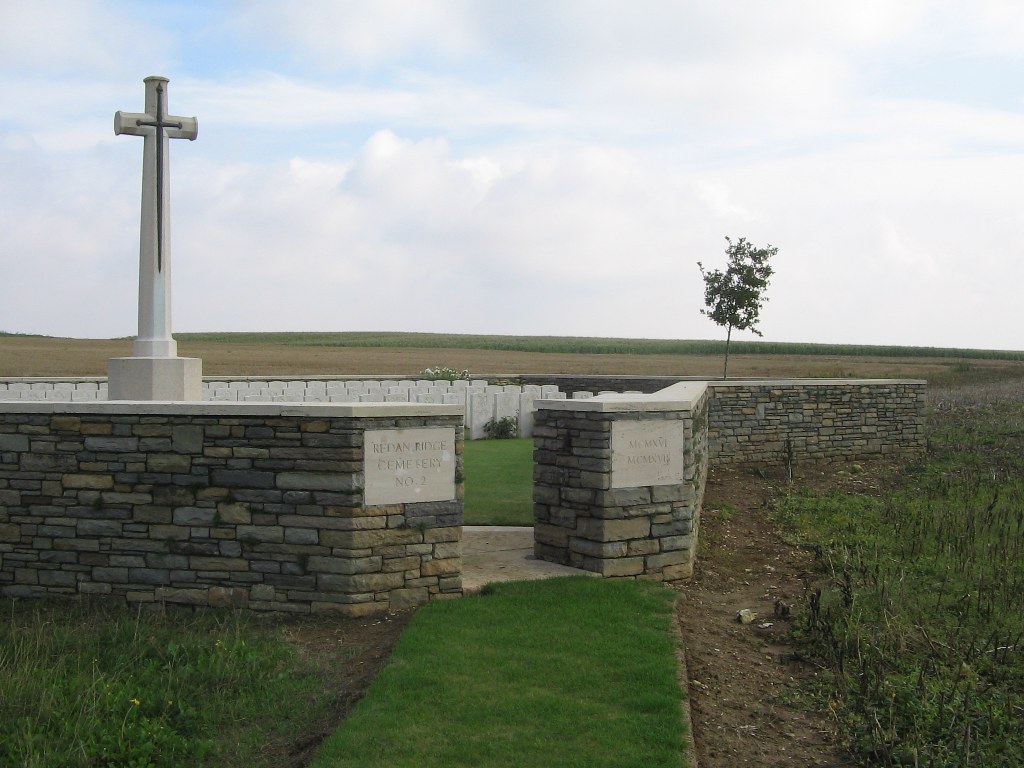 <REDAN RIDGE CEMETERY No 2, BEAUMONT HAMEL
<REDAN RIDGE CEMETERY No 2, BEAUMONT HAMEL
Private Cyril WilliamCHAPMAN 3988 – Service (2nd Sportsman’s) Btn, Royal Fusiliers Ref:C 52
The area was reached on the first day of the battle, but was not finally taken until November 1916 after fierce fighting.
NEWFOUNDLAND MEMORIAL,BEAUMONT HAMEL>
The site is one of the few places on the ‘Western Front’ that a visitor can see the trench lines in relation to the terrain, in a preserved state … delivering the best impression of what the battlefield would have been like.
The area has been maintained because of its significance to Newfoundland … the Newfoundland Regiment attacked here on the 1st July, suffering appalling losses. After the war, the Dominion of Newfoundland purchased this land. It was officially opened by Earl Haig in 1925, and was designated a Canadian National Historic Site in 1996. The statue of the Caribou was chosen for the memorial, as it is a symbol of the regiment.
I visited the park as recently as last year. It represents to me the enormous contribution made by the forces of the Empire, and is a place that preserves the memory of the men of the many other regiments; from the French, British and German armies, who fought and died on this part of the Somme battleground.
Guided tours are conducted by Canadian students … their pride and enthusiasm is always a joy to witness!
“Tread softly here! Go reverently and slow! Yea, let your soul go down upon its knees, And with bowed head and heart abased strive hard To grasp the future gain in this sore loss! For not one foot of this dank sod but drank Its surfeit of the blood of gallant men. Who, for their faith, their hope, -for Life and Liberty, Here made the sacrifice, -here gave their lives. And gave right willingly-for you and me.
From this vast altar-pile the souls of men Sped up to God in countless multitudes: On this grim cratered ridge, they gave their all. And, giving, won The peace of Heaven and Immortality. Our hearts go out to them in boundless gratitude: If ours-then God’s: for His vast charity All sees, all knows, all comprehends-save bounds. He has repaid their sacrifice:-and we-? God help us if we fail to pay our debt In fullest full and unstintingly!”
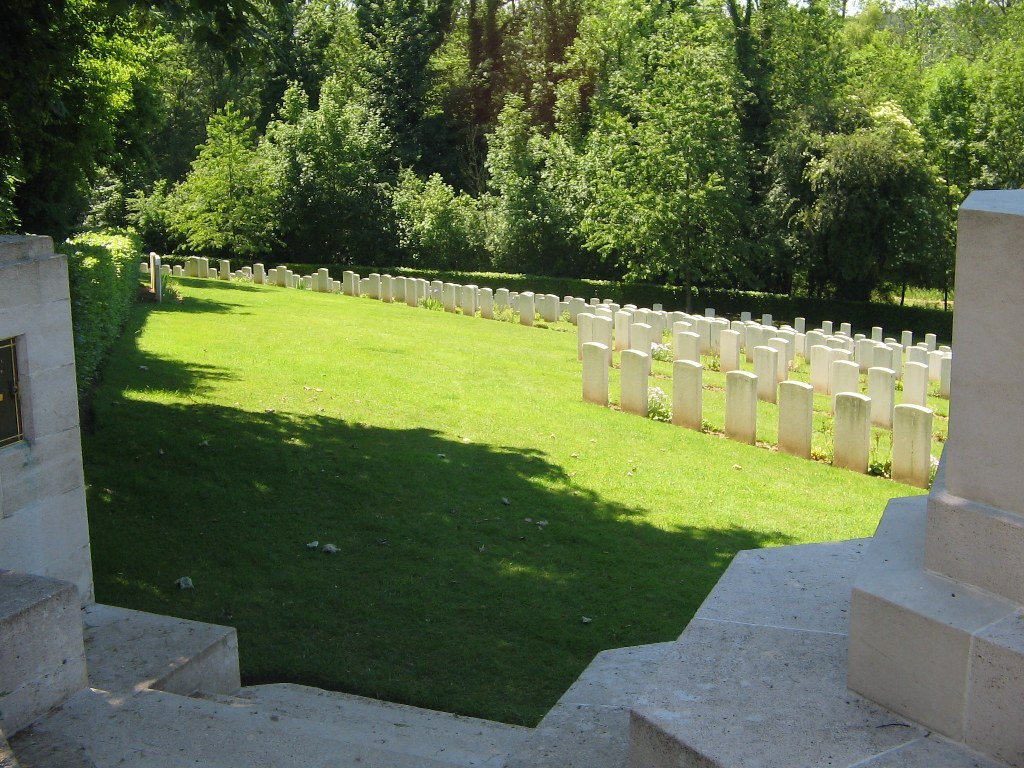 <AUTHUILLE MILITARY CEMETERY, AUTHUILLE
<AUTHUILLE MILITARY CEMETERY, AUTHUILLE
Private Herbert FEENEY 27453 – 15th Btn, Lancashire Fusiliers Ref:A 35
A tribute to the Salford Pals
Authuille was held by British troops from mid-1915 until March 1918. It was then lost and recaptured 4 months later.
–
“Greater love
hath no man than this
that a man lay down his life
for his friends”
~
Day 2 (walk approx. 11 miles) – The Thiepval Memorial is the largest British War Memorial in the world and is where the bulk of MY names are … so it warranted a full day.
I was very keen to look at Pam & Ken Linge’s inspirational database, housed at the museum here. I have not had the opportunity to use it in the past.
After viewing, and photographing them all (not easy, but a ‘labour of love really’!) on the memorial, I sought out an appropriate quiet spot and read out aloud the names of those concerned, this served as my tribute to all at Theipval.
Private Alexander AIRD 17284 – 15th Service (1st Edinburgh)Btn, Royal Scots Ref:7D
Second Lieutenant Wilfrid Joseph Hastings BLINCH – 13th Service Btn, King’s Liverpool Regiment Ref:8CD
Lance Corporal Thomas CHADDERTON 19190 – 13th Btn, King’s Liverpool Regiment Ref:8BD
Private George McAndrew COOK S/10310 – 2nd Btn, Seaforth Highlanders Ref:15C
Private Joseph DAWSON 10015 – 18th Service Btn, Manchester Regiment (3rd City) Ref:14C
Sapper Richard FRANCE 155992 – 175th Tunnelling Coy, Royal Engineers Ref:8A
Private William Arthur GREENHALGH 10022 – 18th Service Btn, Manchester Regiment (3rd City) Ref:14C
Lance Corporal Douglas Duncan HADFIELD 6496 – B Coy, 16th Service Btn, Manchester Regiment (1st City) Ref:14CD
Private Henry HILL 5004 – 20th Service Btn, Royal Fusiliers (3rd Public Schools) Ref:16A
Private Benjamin HUDSON 9299 – 17th Service Btn – Manchester Regiment (2nd City) Ref:14CD
Private (Signaller) Charles JONES S/9776 – 2nd Btn, Gordon Highlanders Ref:15B
Sergeant James Blane MCCORMICK 40357 – 1st Btn, Cameronians (Scottish Rifles) Could not find D
Private John MARSDEN 35532 – 20th Service Btn, Manchester Regiment (5th City) Ref:14C
Private Horatio MATHER 33760 – 17th Service Btn, Manchester Regiment (2nd City) Ref:14C
Private Joseph Percy MATHER S/12301 – 1st Btn, Royal Highlanders (Black Watch) Ref:10A
Private Stephen MORRIS 11206 – 16th Service Btn (2nd Salford), Lancashire Fusiliers Ref:3DD
Private John Wilfrid MORRISON 9894 – 18th Service Btn, Manchester Regiment (3rd City) Ref:14CD
Lance Corporal Frederick Ebern OGDEN 6286 – 16th Service Btn, Manchester Regiment (1st City) Ref:13AD
Second Lieutenant William Kirkpatrick ORFORD – 17th Service Btn, Manchester Regiment (attached to Trench Mortar Battery) Could not find D
Corporal Sydney Arthur PIPER 28241 – 1st Btn, Royal Scots Fusiliers Could not find
Private Ewart Gladstone PROUDMAN 14260 – 1st Btn, King’s Own Royal Lancaster Regiment Ref:12BD
Private Norman Wood RAMSDEN 9521 – 17th Service Btn, Manchester Regiment (2nd City) (formerly 15568 Lancashire Regiment) Ref:14CD
Rifleman Frank Molineaux REANEY S/722 – 12th Btn, Rifle Brigade Ref:16CD
Private Ernest Walker ROBERTS 6298 – 16th Service Btn, Manchester Regiment (1st City) Ref:14C
Private Leonard SCHOFIELD 8863 – 17th Service Btn, Manchester Regiment (2nd City) Ref:14C
Sergeant Arthur SINGLETON 6556 – 16th Service Btn, Manchester Regiment (1st City) Ref:14CD
Corporal Thomas SMITH 16417 – 11th Service Btn, Manchester Regiment Ref:14CD
Private Alfred Norman STUBBS 44184 – 2/8th Btn, Manchester Regiment Ref:14C
Sergeant Herbert THOMPSON 19940 – 42nd Coy, Machine Gun Corps (Infantry) Ref:12C
Rifleman Alfred THREADGOLD C/1560 – 16th Btn, King’s Royal Rifle Corps (Church Lads’ Brigade) Ref:13A
Private Harold TUNSTALL 3579 – 2/6th Btn, Manchester Regiment (Territorial Force) Ref:14C
Rifleman Frederick T.W. WHEELER 3232 – 1/5th Btn, London Regiment, London Rifle Brigade Ref:9D
Sergeant George William WHITE 19033 – 21st Service Btn, Manchester Regiment Ref:14C
Lance Corporal Percy WILKINSON 9955 – A Coy, 18th Service Btn, Manchester Regiment Ref:14C
INFORMATION – I managed to find the vast majority of the above names, and (thanks to my new telescopic camera!) have photographed them all. I would only be too pleased to forward them to anyone interested.
The database is incredible … there are 10,110 (of the 72,000) names on it at present. I have marked a “D” next to the name, if on it. The information is provided by the individual families, so will probably already be known(?). However, if you e-mail Pam, she will provide you with individual details.
To allow me some rest bite from all the research, I took some time to relax and digest the day’s events in the nearby gardens and café (run by the Somme Association, Belfast) of the Ulster Tower … what a wonderfully tranquil place it is these days.
At the entrance to the tower is a plaque commemorating the names of the nine men of the 36th Division who won the Victoria Cross during the Battle of the Somme.
~
Day 3 (walk approx. 14 miles) – This is the day that I retraced the last few day’s of my great-grandfather’s life … in July 1916. By referring to the relevant war diaries, and with the invaluable assistance of the staff of the regimental museum at Fulwood Barracks (Preston), I was able to pinpoint the actual field where he was killed … this INCREDIBLE piece of detail has by far exceeded my original expectations and was, without doubt, the pinnacle of my trip.
You have got to understand, his battalion did not move forward in a logical straight line, as they crept their way to the German trenches, slowly pushing the enemy back. They only saw action in fits and starts, sometimes their plans to attack were cancelled, and they even spent a large period, in the middle of the month, resting and training way behind the front, to the west of Albert.
So what I have done is to do what I do best … to devise a walk (a sort of ‘tribute walk’), that links much of the points that are mentioned in the diary.
LOCHNAGAR CRATAR, LA BOISELLE
The Lochnagar mine was an explosive-packed mine created by the Royal Engineer tunnelling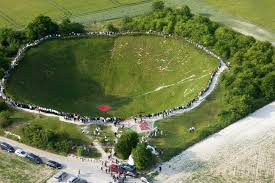 companies, located south of the village of La Boiselle.
companies, located south of the village of La Boiselle.
It was detonated at 0728 (2 minutes before ‘zero hour’) on the 1st of July 1916. The mine, along with a neighbouring one to the north (Y Sap), contained 24 tons of ammonal. At the time, they were the largest ever detonated!
“The whole earth heaved and flashed, a tremendous and magnificent column rose up in the sky. There was an ear-splitting roar drowning all the guns, flinging the machine sideways in the repercussing air. The earth column rose higher and higher to almost 4,000 feet. There it hung, or seemed to hang, for a moment in the air, like the silhouette of some great cypress tree, then fell away in a widening cone of dust and debris”.
The battle was prefaced by an unprecedented seven day (largely ineffective!) artillery bombardment. On the morning of the attack itself, the bombardment reached a crescendo, with a quarter of million shells being sent up. The noise could be heard in London, the boys weren’t in London … they were HERE!
–
GERMAN CEMETERY, FRICOURT
This is the final resting place for over 17,000 German soldiers, brought here from all over the 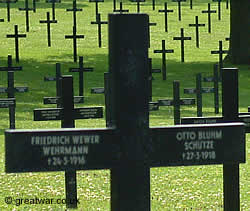 region.
region.
It was not until 1929, with the co-operation of the French government, that the German War Graves Agency was able to begin work building and landscaping the site. This stopped during the Second World War and did not resume until 1966.
The famous pilot Baron Manfred von Richtofen (The Red Baron), who was shot down in April 1918, was first buried in a civilian cemetery but was later moved here, before being exhumed again for re-burial in Germany.
–
Mametz Wood was the objective of the 38th (Welsh) Division. Their memorial is perhaps the most striking of them all(?). It takes the form of a red Welsh Dragon, glaring and spitting fire towards the enemy whilst tearing at barbed wire.
 It sits aside a rough track and is in a lovely looking area known as Vallee Wagnon. It belies the scene of a century ago … then a place of blood and death. I am almost certain that my great-grandfather would have come this way(?)
It sits aside a rough track and is in a lovely looking area known as Vallee Wagnon. It belies the scene of a century ago … then a place of blood and death. I am almost certain that my great-grandfather would have come this way(?)
–
For years afterwards the farmers found them the wasted young,
turning up under their plough blades
as they tended the land back into itself.
A chit of bone, the china plate of a shoulder blade,
the relic of a finger, the blown and broken bird’s egg of a skull,
all mimicked now in flint, breaking blue in white
across this field where they were told to walk,
not run, towards the wood and its nesting machine guns.
And even now the earth stands sentinel,
reaching back into itself for reminders of what happened
like a wound working a foreign body to the surface of the skin.
This morning, twenty men buried in one long grave,
a broken mosaic of bone linked arm in arm,
their skeletons paused mid-dance-macabre
in boots that outlasted them,
their socketed heads tilted back at an angle
and their jaws, those that have them, dropped open.
As if the notes they had sung
have only now, with this unearthing,
slipped from their absent tongues.
CRUCIFIX CORNER, BAZENTIN-LE-GRAND
There were many Crucifix corners on the Western Front. This one is perhaps the best known(?). It was an assembly point for British and Empire troops going through what was known as “Death Valley” (Vallee Wagnon), to attack the German stronghold of High Wood … notice the battle scars!
<
<
<
~
Day 4 (cycle approx. 31 miles) – This is when I hired a bike for the day, to cover the southern and central sections.
 <MEAULTE MILITARY CEMETERY, MEAULTE
<MEAULTE MILITARY CEMETERY, MEAULTE
Lance Corporal George Simpson MATHER 203116 – 6th Btn, Queen’s Own (Royal West Kent Regiment) Ref:E39 Did not visit
Lieutenant Denham WALKER – 2/5th Btn, East Lancashire Regiment (attached to 18th Btn, Machine Gun Corps) Ref:I D48
Did not visit
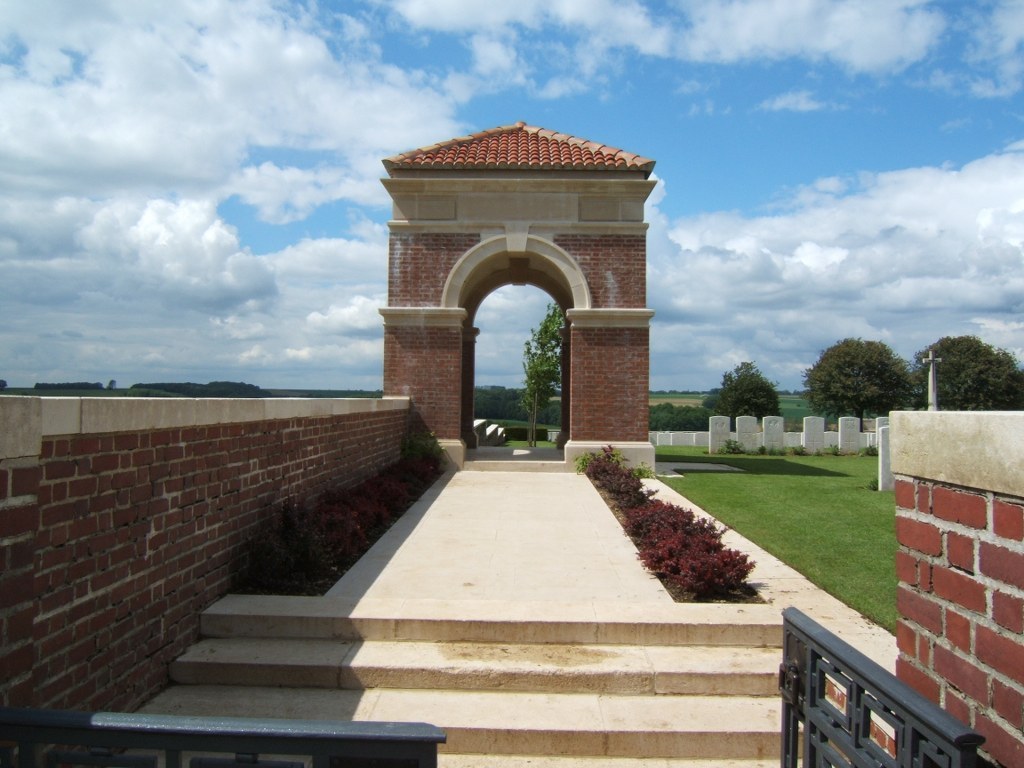 <DANTZIG ALLEY BRITISH CEMETERY, MAMETZ
<DANTZIG ALLEY BRITISH CEMETERY, MAMETZ
Private Arthur CLAY 7632 – 16th Service Btn, Manchester Regiment (1st City) Ref:V U10
Named after a German trench here. The village of Mametz was captured in July 1916. The cemetery was begun in the same month and was used by field ambulances and fighting units until November.
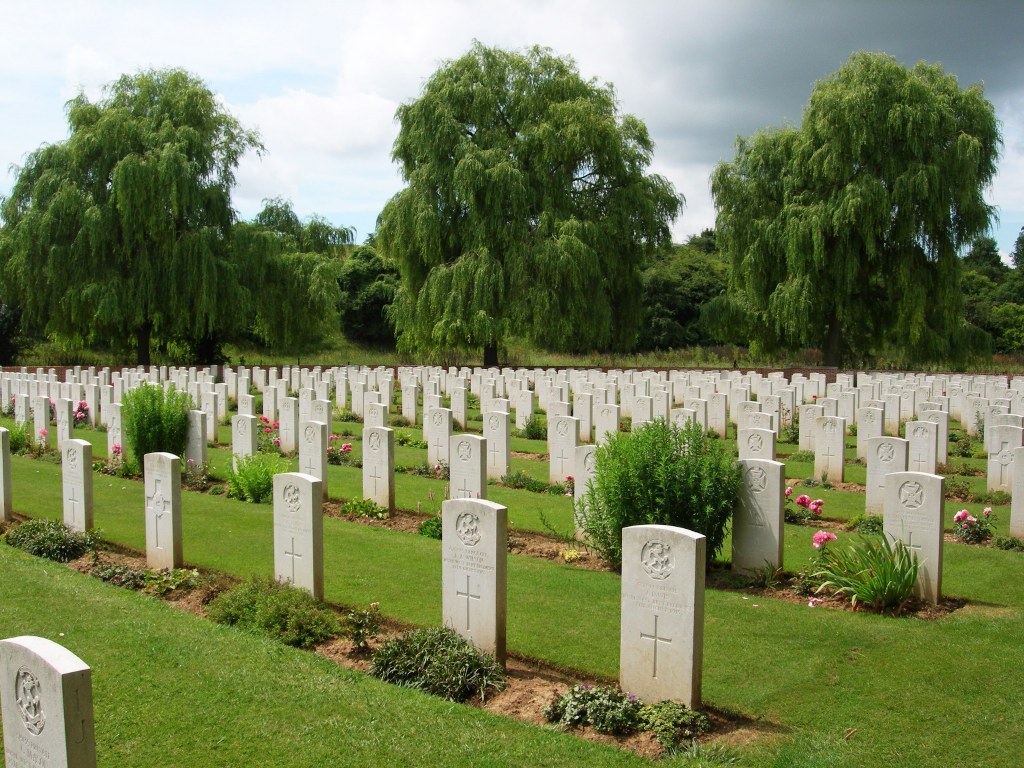 CARNOY MILITARY CEMETERY, CARNOY>
CARNOY MILITARY CEMETERY, CARNOY>
Private Fred COOPE 12301 – 19th Service Btn, Manchester Regiment (4th City) Ref:G12
Private Stanley HILTON 12105 – 19th Service Btn, Manchester Regiment (4th City) Ref:H16
“Greater love hath no man” Began in August 1915, it continued in use by troops holding this sector until July 1916, when field ambulances came up and a camp was established on higher ground. There was originally a German cemetery and graves alongside!
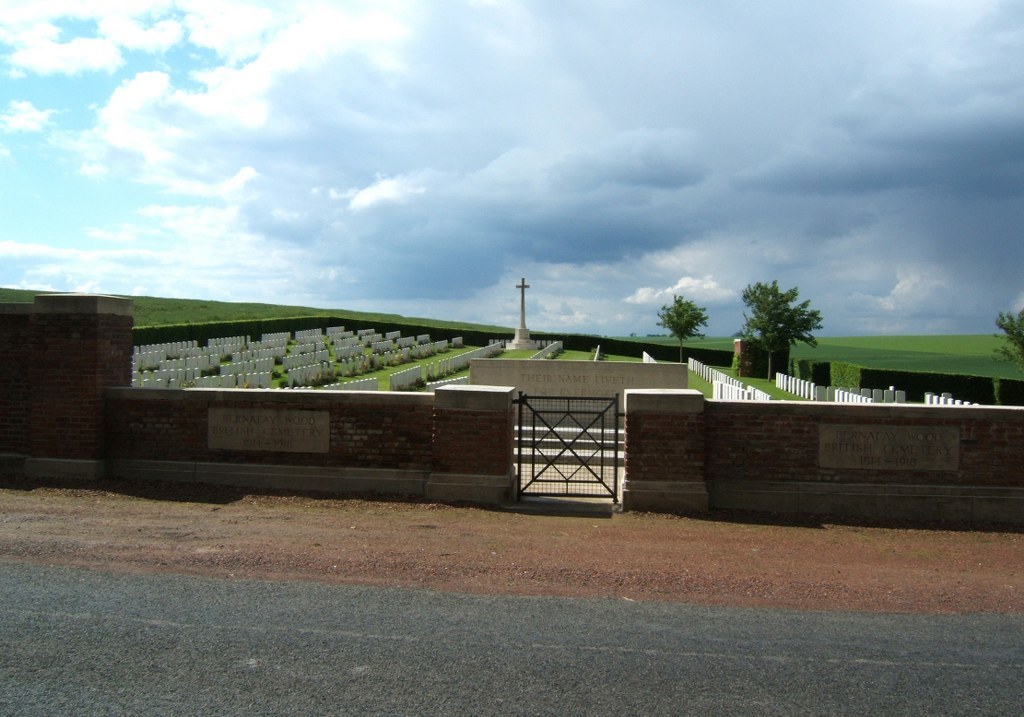 <BERNAFAY WOOD BRITISH CEMETERY, MONTAUBAN
<BERNAFAY WOOD BRITISH CEMETERY, MONTAUBAN
Private Richard WOOTTEN 6312 – 1/4th Btn, Loyal North Lancashire Regiment Ref:E7
“Until the day breaks and the shadows flee away”
Named after the pear-shaped Bois de Bernafay close to the east end village of Montauban village.
 LONGUEVAL ROAD CEMETERY, LONGUEVAL>
LONGUEVAL ROAD CEMETERY, LONGUEVAL>
Gunner Charles BRYSON 122 – 24th Siege Battery, Royal Garrison Artillery Ref:J13
Situated near a dressing station known as “Longueval Alley” or “Longueval Water Point”.
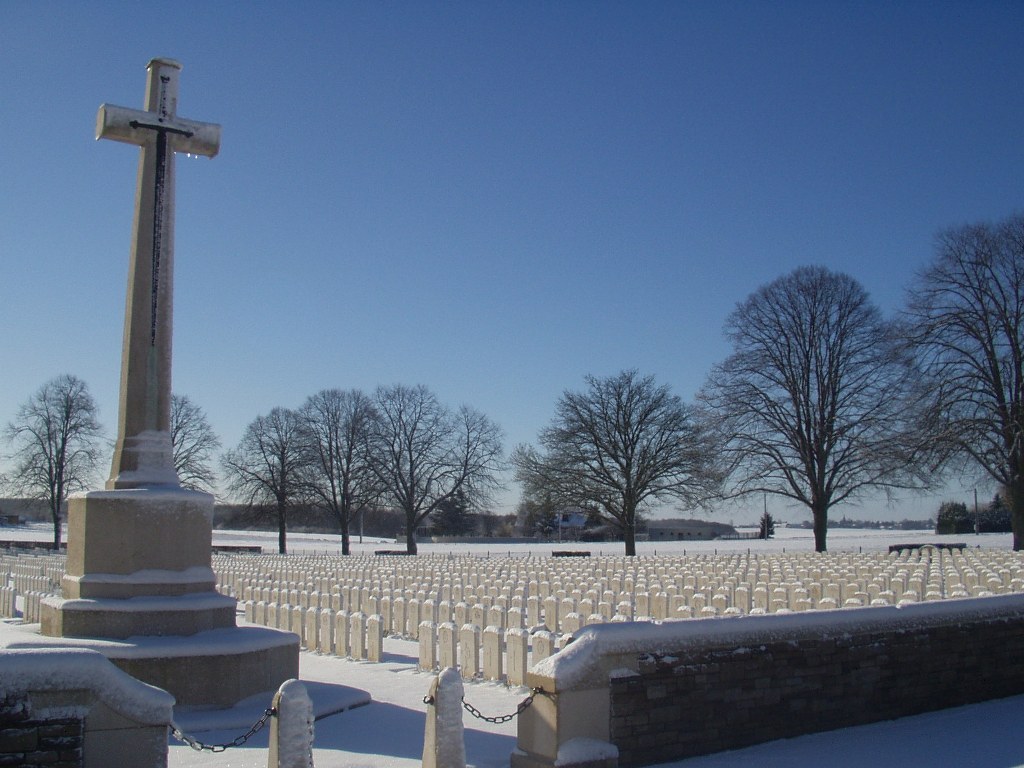 <DELVILLE WOOD CEMETERY, LONGUEVAL
<DELVILLE WOOD CEMETERY, LONGUEVAL
Corporal Samuel DAVIES B/2853 – 3rd Btn, Rifle Brigade Ref: XXX D4
“He was sacrificed for the cause of the living”
Named after the wood (“Devil’s Wood”) to the east of Longueval village.
 DELVILLE WOOD SOUTH AFRICAN MEMORIAL, LONGUEVAL
DELVILLE WOOD SOUTH AFRICAN MEMORIAL, LONGUEVAL
This magnificent National Memorial commemorates South Africans of all theatres of war and is the site of the great sacrifice they made.
Accessed by an oak-lined grass avenue, the memorial is a flint and stone screen with a shelter on each end. The middle arch is surmounted by figures of a horse and two men (representing the two races of the Union) in bronze.
You can walk through the woods, along with some very familiar-sounding streets(?).
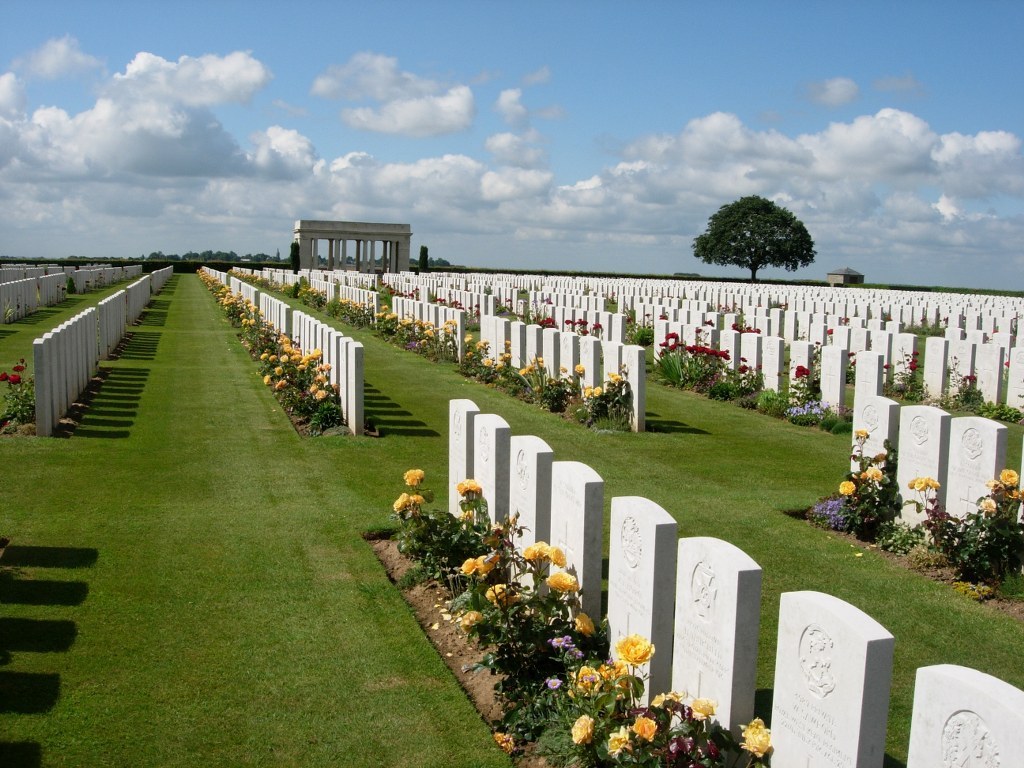 <CATERPILLAR VALLEY CEMETERY, LONGUEVAL
<CATERPILLAR VALLEY CEMETERY, LONGUEVAL
Lance Corporal Harrie Cecil COX 4657 – 20th Service Btn, Royal Fusiliers (3rd Public Schools) Ref:VI C38
Caterpillar Valley was the name given by the troops to this winding valley.
 CATERPILLAR VALLEY CEMETERY, NEW ZEALAND MEMORIAL TO THE MISSING, LONGUEVAL
CATERPILLAR VALLEY CEMETERY, NEW ZEALAND MEMORIAL TO THE MISSING, LONGUEVAL
I fulfilled a promise to pay tribute to the men of New Zealand.
Over half of the New Zealanders who died on the Somme have no known grave, they are commemorated here.
One did return home, however, in 2004 … his remains were exhumed and, in a ceremony on the 6th November, were entrusted to the New Zealand authorities. He now lies in the “Tomb of the Unknown Warrior” outside the National War Memorial in Wellington.
“From the uttermost ends of the Earth”
High Wood was the last of the major woods in the Somme offensive of 1916 to be captured by the British. Despite a whole series of attacks, High Wood held out for two months. Even the cavalry saw action, using lance and horse alongside machine-gun … weapons that spanned centuries of technology!
It was never fully cleared after the war, and it is estimated that the remains of around 8000 soldiers, British and German, still lie in the wood!
–
This is where I ended my story … on the banks of the river that gave its name to one of the most 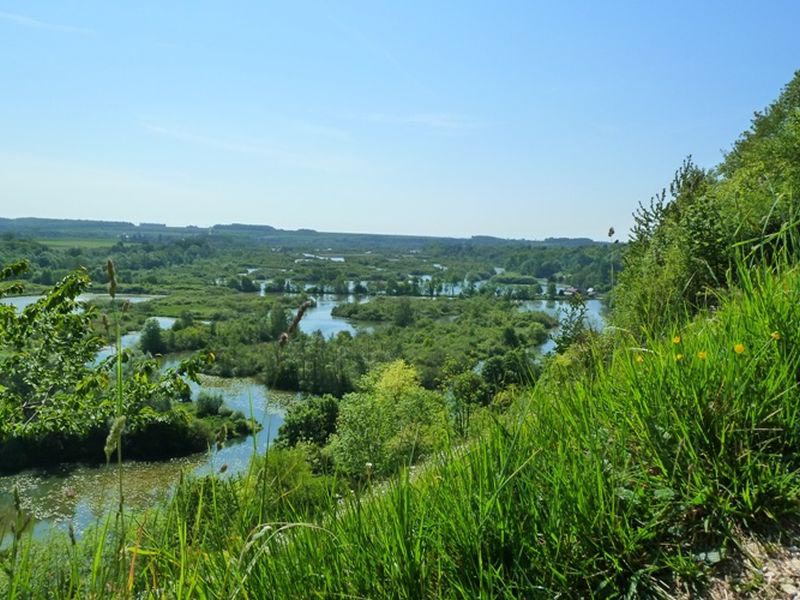 horrific battles in human history.
horrific battles in human history.
It is rather ironic that “Somme” comes from the Celtic word meaning “tranquillity”!
Despite playing little part in the battle (although hospital barges plied from the front to Amiens), it roughly represented the dividing line between the French and British armies … and it is where the French (on THEIR soil) could keep an eye on us!
–
The town of Albert was my home for a week, I set aside some time to explore it.
A famous building in the town centre during the war was the Basilica Notre-Dame de 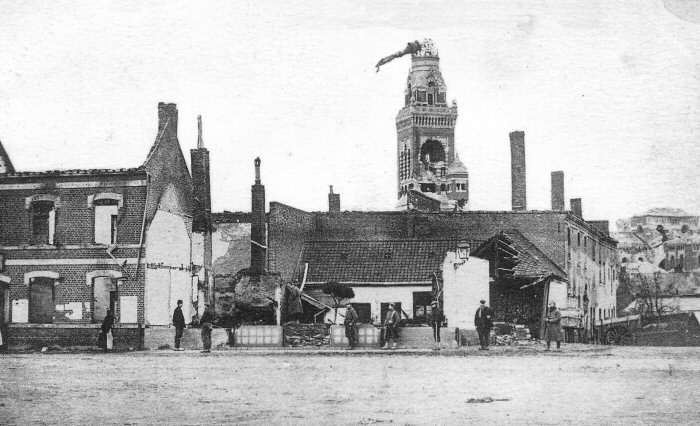 Brebieres, with its golden statue of the Virgin Mary and her infant son Jesus, on the tower.
Brebieres, with its golden statue of the Virgin Mary and her infant son Jesus, on the tower.
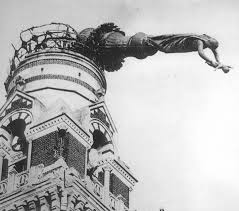 In January 1915 the statue was damaged by an artillery shell and knocked onto its side. It remained in this precarious state until April 1918, when the British destroyed the basilica, to prevent the Germans from using it as an observation tower during their counter-attack occupation of Albert.
In January 1915 the statue was damaged by an artillery shell and knocked onto its side. It remained in this precarious state until April 1918, when the British destroyed the basilica, to prevent the Germans from using it as an observation tower during their counter-attack occupation of Albert.
The troops believed that when the statue fell, the war would be over!
~
THE PRESTWICH CONNECTION …
William DOBSON – his last recorded address is 9 Milton Road, Prestwich
Alec WISKEN – son of Harry & Margaret Wisken of 1 Milton Road, Prestwich
Cedric WHITAKER – son of William & Eliza Whitaker of 4 Queen’s Drive, Prestwich
William CHAPMAN – son of James & Agnes Chapman of 21 Grosvenor Street, Prestwich
Alexander AIRD – youngest son of Alexander & Elizabeth Aird of 22 King’s Road, Prestwich
Wilfrid Joseph Hastings BLINCH – son of Mary Blinch of 25 Mountfield Road, Prestwich
Thomas CHADDERTON – son of James & Sarah Chadderton of 13 Albion Place, Prestwich
George McAndrew COOK – son of George & Elizabeth Cook of 26 Egerton Street, Prestwich
Joseph DAWSON – son of David & Elizabeth Dawson of 1 Park Street, Prestwich
Richard FRANCE – son of Richard & Isabella France of 19 Kersal Road, Prestwich
William Arthur GREENHALGH – son of John & Sarah Greenhalgh of 43 Ogden Street, Prestwich
Duncan HADFIELD – son of James & Mary Jane Hadfield of 61 Clifton Roa,d Prestwich
Henry HILL – his last address is recorded in St Mary’s Book of Remembrance as “Wynatts Knoll”
Benjamin HUDSON – born in Prestwich and was the son of David & Emma Hudson
Charles JONES – son of Charles & Martha Ann Jones of 12 North Road, Prestwich
James Blane MCCORMICK – son of James & Agnes McCormick of 2 Derby Street, Prestwich
John MARSDEN – married to Annie Marsden of 21 Harrogate Avenue, Prestwich
Horatio MATHER – son of William & Jane Mather of 21 Park Street, Prestwich
Joseph Percy MATHER – son of Joseph & Emily Mather of 187 George Street, Prestwich
Stephen MORRIS – son of Stephen &Lavinia Morris of 40 Chapel Road, Prestwich
John Wilfrid MORRISON – it appears that he was raised by his grandparents, William & Mary Morrison of 29 Rainsough Brow, Prestwich
Frederick Ebern OGDEN – his parents lived at 33 Richmond Avenue, Prestwich
William Kirkpatrick ORFORD – son of Lewis Alfred, clerk to Prestwich DC & Frances Elizabeth Orford of 5 Wilton Polygon, Crumpsall
Sydney Arthur PIPER – son of Walter & Elizabeth Piper of 2 North Road, Prestwich
Ewart Gladstone PROUDMAN – son of Sarah Proudman of 3 Stores Street, Prestwich
Norman Wood RAMSDEN – son of Annie Ramsden of 23 The Crescent, Deyne Avenue, Prestwich
Frank Molineaux REANEY – son of Mary Jane Reaney of 82 Bury Old Road, Kirkhams
Ernest Walker ROBERTS – son of Frederick & Sarah Roberts of Westfield, Gardner Road, Prestwich
Leonard SCHOFIELD – son of Ellis & Alice Schofield of “The Firs”, Polefield Road, Prestwich
Arthur SINGLETON – married Ada Gertrude Crossland in Prestwich
Thomas SMITH – brother of Elizabeth Horican of 19 Whittaker Lane, Prestwich
Alfred Norman STUBBS – son of Joseph Barker Stubbs and lived at 57 Rectory Lane, prior to moving to 22 Fairfax Road, Prestwich
Herbert THOMPSON – son of Bartlett & Elizabeth Thompson of Sedgley Park Cottage, King’s Road, Prestwich
Alfred THREADGOLD – born in Prestwich and son of Samuel & Edith Threadgold of 17 The Crescent
Harold TUNSTALL – son of Thomas James & Sarah Matilda Tunstall of 16 Mowbray Avenue, Prestwich
Frederick T.W. WHEELER – son of Frederick & Eliza Josephine Wheeler of 14 Fairfax Road, Prestwich
George William WHITE – son of John & Eliza White of 13 Elizabeth Street, Prestwich
Percy WILKINSON – son of John & Mary Wilkinson of 102 Bury New Road, Prestwich
George Simpson MATHER – son of William & Jane Mather of Park Street, Prestwich
Denham WALKER – born in Prestwich and son of Walter Egerton Walker & Mary E Walker of Stoneleigh, Higher Crumpsall
Arthur CLAY – on enlistment, he gave his address as 112 Simister Lane, Rhodes
Fred COOPE – son of William & Mary Ellen Coope of 2 Dashwood Road, Prestwich
Stanley HILTON – son of John &Selina Hilton of 1 Half Acre, Prestwich
Richard WOOTEN – son of Richard & Louisa Wooten of 21 Stanley Street, Heaton Park
Charles BRYSON – son of John & Alice Bryson of Lower Broughton
Samuel DAVIES – son of J.Senior& Clara Davies of Sunny Mead 124 Bury Old Road, Prestwich
Harrie Cecil COX – his address is recorded in St Mary’s Book of Remembrance as 34 Richmond Avenue, Prestwich
Source and for further information: “In Splendid Manner” by David Galloway
Book Availability – Prestwich Library / Bury Library / Lancashire Fusilier Museum, Bury
Contact: galloway794@btinternet.com
~
~~~~~~~~~~~~~~~~~~~~~~~~~~~~~~~~~~~~~~~~~~~
Centenary Commemorations
I was delighted to learn that my home city of Manchester was chosen to host the national commemoration for the Battle of the Somme. This included a service at Manchester Cathedral, followed by a heritage experience and evening concert at Heaton Park.
The park was a military training ground for soldiers during the war, and Heaton Hall was a hospital. A century on, a wonderful selection of enthusiasts from across the country came here to tell stories and accounts of people from 1916 … included was a range of drop-in activities, exhibitions, scheduled talks and mini-performances.
I did manage to get to the park (a mere one mile from my front door!) on the Saturday (2nd) and would like to express my gratitude to the organisers and participants for their considerable efforts in producing a memorable occasion.
~
For my tribute I had to travel a little further afield … there was only one place that came to mind … it was not the grandeur of  Thiepval or even Manchester, but somewhere I felt overwhelmingly drawn to.
Thiepval or even Manchester, but somewhere I felt overwhelmingly drawn to.
I have no personal connection with the town of Accrington, but (as in 2014) chose the memorial to ‘The Pals’, this one in Haworth Park, as my place of pilgrimage. A replica of the one at Serre stands proudly here on a hill in the park, I presume to overlook the town(?) … the thick woodland would not allow me to corroborate this(?). It was warming too to discover that so many youngsters were involved in this project.
